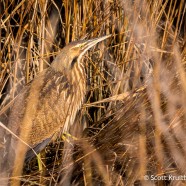Ranitomeya vanzolinii
One of Twan’s all-time favorite dart frogs, Ranitomeya vanzolinii. He says that they’re tiny and secretive, but whenever you manage to get a good look, they take your breath away! Photographed for the Meet Your Neighbours global diversity project.
Read MoreAmerican Bittern
This is the American Bittern (Botaurus lentiginosus), a stupendously cryptic and sensationally camouflaged heron species of freshwater and brackish marshes and wetlands. During late fall and winter they can be infrequently found moving south to warmer or coastal areas where the water does not freeze. Even their movements are meant to blend in perfectly to surrounding vegetation, stalking prey including fish, amphibians, insects, mammals, reptiles, and more. The American Bittern was once a terror in the night to many early American settlers who lived in coastal regions. Its pumping, gurgling,...
Read MoreSuzuki’s Promalactis (Promalactis suzukiella)
Happy National Moth Week! We will be showing you many cool species over the next week so we can all appreciate these incredible insects even more. I have a bunch of individuals that I still have to key out from mothing during the past couple of months, and I have tried to do some field work at least every week or two with them. This was one of my first finds last night, and I swear that I knew immediately when looking at it that it would be a non-native species. It seemed divergent to me in some way. Even though many North American moths are staggeringly beautiful, with vibrant shades, odd...
Read MoreLong-eared Owl (Asio otus)
Here’s an old photo from one of my point and shoot cameras, zoomed in quite far about 30 times and further cropped, of a Long-eared Owl (Asio otus) roosting in a tree. Taking such a photo during the daylight hours, in the bright winter sun, of such a sensitive bird species should only be done from far away. You do not want to risk disturbing or flushing them from their location as Long-eared Owls are especially sensitive to human intrusion. They will be alarmed easily and fly from the location, exposing them to attacks from other predators and mobbing by songbirds. They will also often...
Read MoreIllegal Snake Collection
This story from USFWS Northeast Region concerning the illegal collection and sale of wild reptiles is precisely the reason that we as an organization and as scientists are so careful about disclosing sensitive biological information. It is why I was and will be extremely secretive about locations of species like Timber Rattlesnakes whether it is to protect them from collection or from death. While most people are certainly considerate of life in the world around us there will always be a select misguided few who seek to profit or lash out from ignorance. I am hopeful our constant education...
Read More








